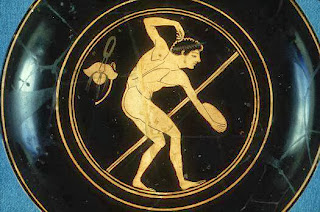One myth says that the guardians of the infant god Zeus held the first footrace, or that Zeus himself started the Games to celebrate his victory over his father Cronus for control of the world. Another tradition states that after the Greek hero Pelops won a chariot race against King Oenomaus to marry Oenomaus's daughter Hippodamia, he established the Games.

Boxing: Ancient boxing had fewer rules than the modern sport. Boxers fought without rounds until one man was knocked out, or admitted he had been beaten. Unlike the modern sport, there was no rule against hitting an opponent when he was down.
There were no weight classes within the mens' and boys' divisions; opponents for a match were chosen randomly. Instead of gloves, ancient boxers wrapped leather thongs (himantes) around their hands and wrists which left their fingers free.
Chariot Racing: There were both 2-horse chariot and 4-horse chariot races, with separate races for chariots drawn by foals. Another race was between carts drawn by a team of 2 mules. The course was 12 laps around the stadium track (9 miles).

Riding: The course was 6 laps around the track (4.5 miles), and there were separate races for full-grown horses and foals. Jockeys rode without stirrups.
Only wealthy people could afford to pay for the training, equipment, and feed of both the driver (or jockey) and the horses. As a result, the owner received the olive wreath of victory instead of the driver or jockey.
 Pankration: This event was a grueling combination of boxing and wrestling. Punches were allowed, although the fighters did not wrap their hands with the boxing himantes. Rules outlawed only biting and gouging an opponent's eyes, nose, or mouth with fingernails. Attacks such as kicking an opponent in the belly, which are against the rules in modern sports, were perfectly legal.
Pankration: This event was a grueling combination of boxing and wrestling. Punches were allowed, although the fighters did not wrap their hands with the boxing himantes. Rules outlawed only biting and gouging an opponent's eyes, nose, or mouth with fingernails. Attacks such as kicking an opponent in the belly, which are against the rules in modern sports, were perfectly legal.Jump: Athletes used lead or stone jump weights (halteres) shaped like telephone receivers to increase the length of their jump. The halteres were held in front of the athlete during his ascent, and forcibly thrust behind his back and dropped during his descent to help propel his body further.
Running: There were 4 types of races at Olympia. The stadion was the oldest event of the Games. Runners sprinted for 1stade (192 m.), or the length of the stadium. The other races were a 2-stade race (384 m.), and a long-distance run which ranged from 7 to 24 stades (1,344 m. to 4,608 m.). And if these races weren't enough, the Greeks had one particularly grueling event which we lack. There was also a 2 to 4-stade (384 m. to 768 m.) race by athletes in armor. This race was especially useful in building the speed and stamina that Greek men needed during their military service.
Wrestling: Like the modern sport, an athlete needed to throw his opponent on the ground, landing on a hip, shoulder, or back for a fair fall. 3 throws were necessary to win a match. Biting was not allowed, and genital holds were also illegal. Attacks such as breaking your opponent's fingers were permitted.
Student's will write a 4-6 sentence paragraph describing about on of the sports that were played during the Ancient Olympics.






Some of the sports that were practiced in the ancient Olympics are still part of the modern Olympic games. The sports we still see Boxing, wrestling, javelin throw, running, jumping, and the discus throw, and riding. While pankration, and chariot racing have been replaced by other sports, the addition of winter sports is a break from the ancient tradition
ReplyDeleteYou successfully went in depth when describing each Olympic sport. Your content will show the students how certain sports in the previous Olympics still take place today but they have simply been altered over time. Including pictures for every sport helped create more specific imagery.
ReplyDeleteI think you did a great job explaining each sport in depth, giving the students a good basis to write their responses. The organization of your blog is clear and the addition of the pictures helps students to visualize each sport. One recommendation I have for your blog is that maybe you could add some explanation of some of the more difficult terms that the students may not be familiar with or would have difficulty deciphering meaning from the context because it is an ancient sport not used in modern times.
ReplyDeleteI like the way this blog was set up with the pictures and the bold text. I think this set up lets your students browse through your blog in more nonlinear way. It lets them quickly find the information which they find most interesting. Your question also lets them focus on whichever sport they find most interesting.
ReplyDeleteAgain, since I already answered all of your questions.....I obviously think this is an engaging blog. I like the pictures of the pottery that go with the games. Good amount of information and interesting, engaging questions.
ReplyDeleteI loved how after describing each sport you displayed a picture next to it. This can give students a clearer idea of what the sport was. The content was very well researched and detailed. I liked the question at the end of your blog. This allows for students to use their imagination.
ReplyDeleteThis was a great description of the Olympic Sports. I like the boldness of the pottery depicting each sport and I believe the students would be more engaged because of this. It would allow them to be more descriptive and give them a better visual when completing the writing assignment at the end.
ReplyDelete